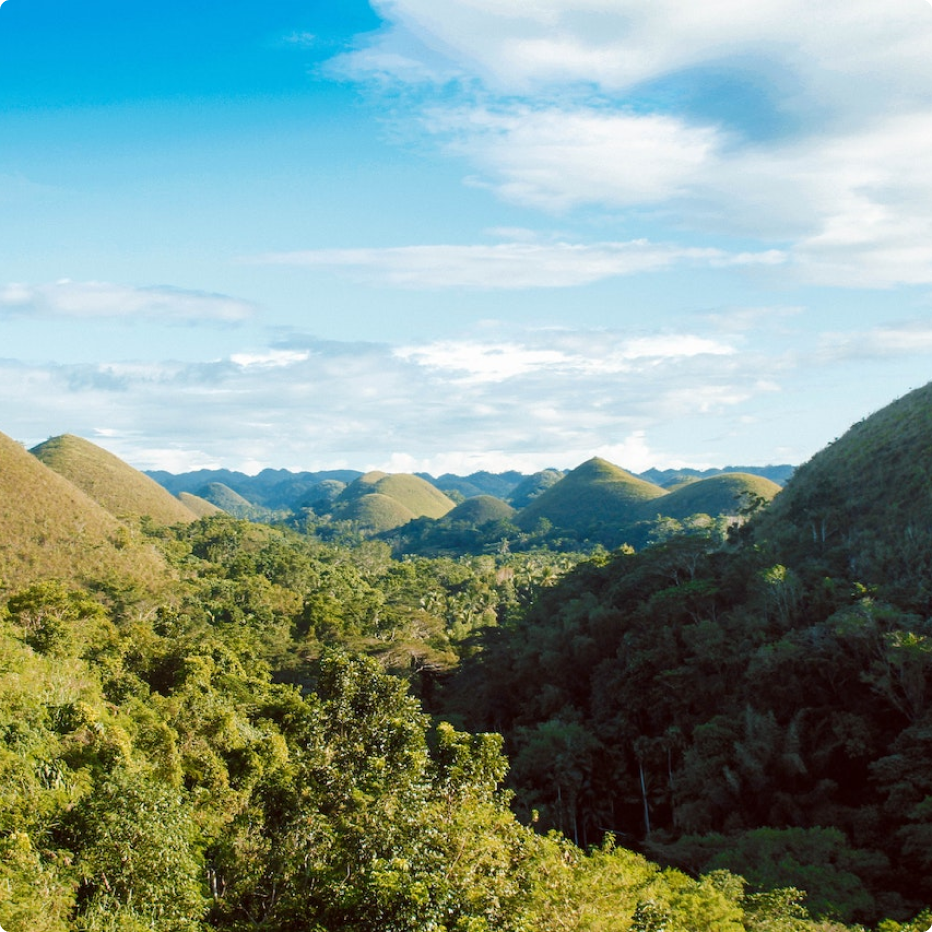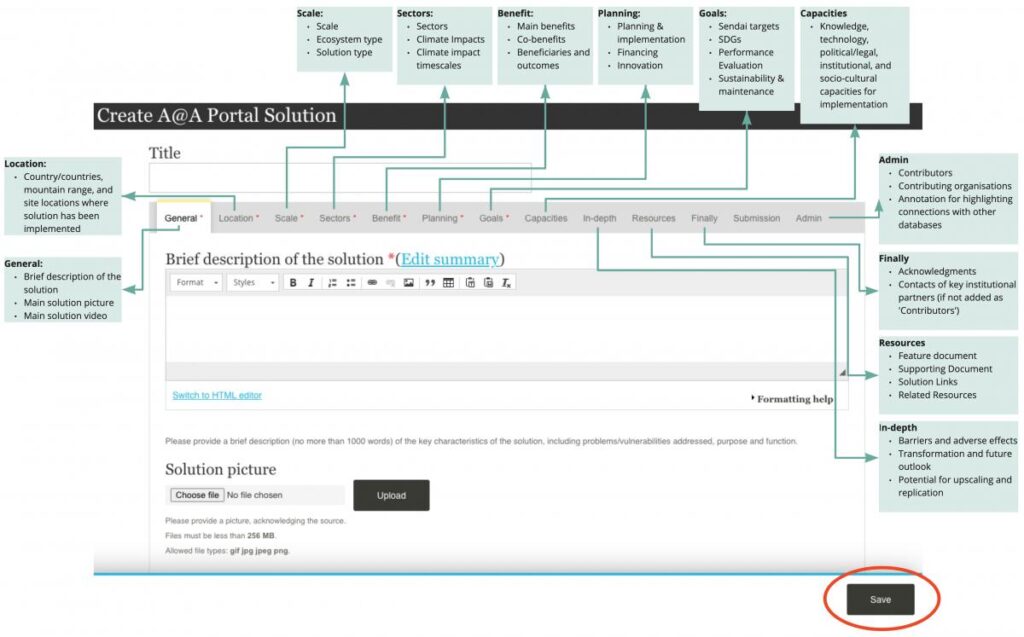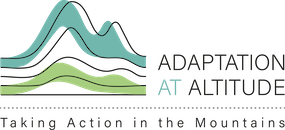Portal Guide
Adaptation at Altitude Solutions Portal: Guidance
Thank you for engaging with the A@A Solutions Portal! You can find detailed guidance on how to contribute a solution below. Scroll down for a step by step guide for contributing a solution to the A@A Solutions Portal.


Contributed before?
Click here to jump to the solution entry template [online version]. You can save your draft solution as you go. Once finalised, you can submit the solution by saving and clicking ‘Submit’ on the formatted view of the solution. Alternatively, you can download our solution entry template form and email us the completed version.
Key information
What is a ‘solution’?
For this portal, ‘solutions’ are defined as technologies, approaches, and/or processes to adjust natural or human systems to actual or expected climate impacts, in order to reduce expected losses or harness benefits. For example, a solution could be an early warning system or an education programme associated with it, but it could also be a combination of both.
Have knowledge to share but not sure it is a ‘solution’? You can also share and find relevant knowledge, make announcements and start discussions in the Climate Change Adaptation in Mountains theme on weADAPT: https://weadapt.org/knowledge-base/adaptation-in-mountains/
Why share your solution?
Sharing knowledge in ways that are easy for people to discover, filter and appraise helps others to replicate successful interventions and learn from past experiences. This is essential for expediting climate action globally, and avoiding the replication of past mistakes. It is also a great way of increasing the visibility of your work: we share contributed solutions through our social media feeds and newsletters (see ‘Spread the Word! below), at events and in publications, to help them reach new audiences.
Who can contribute a solution?
Anyone who has been directly implementing or working with those implementing a solution can contribute a solution to this portal. This includes (but is not limited to) individuals, practitioners, and researchers from community level organisations, civil society organisations, charities, non-government organisations, governmental departments, universities, research institutes etc. You are also welcome to share details of other solutions you know of and think should be included. For questions and suggestions, please contact the team via info@weADAPT.org
Short vs detailed solutions
Short solutions contain less information and are intended for pilot solutions and those early on in their implementation. Detailed solutions provide comprehensive, in-depth knowledge on established solutions and have been designed to meet the needs of decision-makers and practitioners looking for solutions they can implement.
Contributing a solution to the A@A Solutions Portal
Overview
Solutions can be completed and submitted using the offline or online solutions template. Please see the information below about how to submit using each method, and how to complete the required information. Solutions will be reviewed using evaluation criteria here.
Using the offline template
Solutions can be added via the offline solution template. If completing an offline version please email the completed document to info@weADAPT.org. This will then be shared with the Adaptation at Altitude team who will reach out to you for any questions or clarifications. Please share any images and multimedia you wish to be included on the solution, as well as any links to external resources or relevant files.
Using the online template
The online template gathers information through a series of tabs containing text fields and drop-down lists. There are options to add pictures, videos, documents, and URL links. If you wish to, you can add additional multimedia to your solution. Once you have finalised your solution, you can submit the solution by saving and clicking ‘Submit for review’ on the formatted view of the solution. The solution will then be reviewed by the A@A Portal Team.
Key points:
- Fields marked with an asterisk * are required. ‘Short solutions’ must complete these fields. ‘Detailed solutions’ must provide responses across most fields.
- If using the online template, we recommend that you save your edits regularly (click ‘Save’ at the bottom of the template). When you save, you will be taken to a formatted view of the solution. To continue editing click on ‘Edit’ above the title.
- If using the online template, options can be selected (and de-selected) from lists by clicking on the relevant terms.
- The lists have an option to add additional options under “Other (please specify)”. Entries here will be reviewed and the lists updated accordingly – thank you for your contributions here.

Detailed guidance on contributing a solution
- If you are completing the online template you will need to register and create an account. This is so that you can save and edit your draft solution, and so that your user profile is associated with the solution. This allows people interested in your work to contact you.
- Add a Title for your solution.
- Complete the forms available under the different tabs.
Click the tabs below to explore in-detail information required for each section of the template.
-
- *Brief description of the solution. This provides an overall summary of your solution. Click ‘Edit Summary’ to provide a teaser (1-2 sentences) that will appear in portal searches.
- Solution video. Enter a title and URL (YouTube preferred.)
- Solution image. Upload an image. Share a description and attribution under ‘Image attribution’. This image will appear in the portal alongside the title and summary teaser.
-
- *Solution location (list: countries), whether the solution was implemented in more than one country, and other countries where the solution has been implemented. [Multiple choice]
- *Mountain range, region/province (if applicable), and site locations where solution has been implemented. [Free text]
-
- *Scale: Local, Sub-national/Regional, National, Transboundary, Global. [Multiple choice]
- *Mountain ecosystem type(s): Lakes and rivers, desert, grassland, urban, agricultural land, forest, high alpine, meadows, peatland, other (specify). [Multiple choice]
- *Solution type(s): Policy, finance, engineering, monitoring, technological development, research, education and awareness, land use practice, other (specify). [Multiple choice]
-
- *Main benefit associated with the solution implementation: Climate risk reduction (e.g. reduced risk from floods), social benefits (e.g. poverty reduction, inclusiveness and equity, health and well-being), technical benefits (e.g. innovative use of geographic information systems), economic benefits (e.g. job creation, tourism), environmental benefits (e.g. biodiversity preservation, water security, food security), political benefits (e.g. reduced displacement/migration), other (specify). [Multiple choice]
- *Co-benefits(s) associated with the solution implementation: (as above). [Multiple choice]
- *Main beneficiaries, availability and outcomes. Provide details on: who the main beneficiaries of the solution are and how they benefit from the solution; whether the solution is widely available; and if there are differential outcomes for elderly, women, men, youth, poorer communities, indigenous people etc.
-
- *Planning and implementation. Indicate the main organisation in charge of planning and implementation and briefly describe the process (i.e. list of activities) that lead to implementation, including the role of stakeholders and their involvement.
- When implementation started and ended.
- *Who financed the project. Share details on how finance was provided (e.g. loans, credit, grants, subsidies), the total cost (USD) of the solution, and details of any cost-benefit analysis, if one has been conducted (including what indicators were used, the role of the private sector, and/or what activities the costs refer to (e.g. labour, equipment, construction material etc.
- *Innovation. Describe the key innovative aspect of the solution, particularly with respect to CCA in mountains.
-
- *Sendai Framework targets addressed. [Multiple choice]
- *Sustainable development goals addressed (1 – 17). [Multiple choice]
- Performance evaluation. Indicate if a performance/impact evaluation been conducted, and if yes: by whom, when this was done, what key criteria were taken into account, and if these indicators were measured with field data.
- Long term project sustainability and maintenance. Please describe the maintenance activities are in place (if any), how long are these in place for, and who will take long-term ownership/costs of the solution maintenance (e.g., government, organisation, community etc.). Please also indicate whether an environmental monitoring assessment been conducted.
-
- (For each capacity indicate, on a scale of 1 to 5, how would you evaluate the importance of knowledge capacities in enabling this solution.)
- Knowledge capacities. Describe the role of available (scientific and indigenous) knowledge play in the design and implementation of the solution, whether research was part of the solution, and what experience and technical support has been made available to the community benefiting from the solution.
- Technology capacities. Describe the role of available technologies (e.g., geographic information systems) in the design and implementation of the solution.
- Political / Legal capacities. Describe the role available policies, strategies, and laws played in the design and implementation of the solution, whether there has been a clear mandate to implement the solution, and to what extent motivation (e.g., of some authorities or politicians) contributed to implementation.
- Institutional capacities. Describe the role the collaboration between project and local partners has played, what coordination mechanisms (e.g., of government ministries) have been put in place, and how this coordination worked/was facilitated.
- Socio-cultural capacities. Describe the role the social context played (e.g., engagement of NGOs, advocacy coalitions), the extent of engagement of local communities in the co-development and/or implementation of the solution, and whether there were any opponents to the solution. Please indicate if a stakeholder analysis was performed and how it was undertaken.
-
- Barriers and adverse effects. Describe any barriers have you experienced, and if and how they were successfully overcome. Please indicate whether the solution has had, or may have any known or expected side/adverse effects (e.g., on ecosystem, on equity in risk distribution) now and in the future.
- Transformation and future outlook. Describe how the solution caused or supported fundamental change and how will the solution will cope with future climate related changes (e.g. extreme events, gradual climate change, climatological disasters).
- Potential for upscaling and replication. Describe, based on your learnings, whether upscaling of this solution is desirable, and what is required for this to be done successfully. Indicate if the solution is included in a CCA plan or strategy (e.g. National Adaptation Plan) and whether it has been replicated, e.g., using large scale financing (e.g. World Bank), and if so, where and how.
-
- Featured document. Upload a key document for the solution. This could be a major report or publication providing an overview of the solution.
- Supporting documents. Upload any supporting documents. Examples of supporting documents include could documentation of the methodologies used, funding details, associated policy actions, monitoring and evaluation reports, resulting journal articles.
- Solution links. Add URL links to relevant websites, e.g., the associated project website, links to associated news articles.
- Selected resources. Here you can add any additional resources, content or links to related content, for example links to other solutions if your solution is part of a programme comprising multiple solutions. Click ‘Add new node’ and another drop-down selection allows you to choose either ‘Downloads’, ‘Links’ or ‘Text’.
-
- Acknowledgments. Please use this space to acknowledge partners (if not added as ‘Contributors’), communities, organisations etc. who have been involved in the solution.
- Is there anything you would like to add with respect to CCA in mountains? You can use this space to share your thoughts and needs relating to CCA in mountains. The A@A Programme is ongoing to end 2023 and will try to respond to issues and needs raised.
- Contacts of key institutional partners involved with the solution planning and implementation. Please share contact details of the key partners involved in the solution IF they are not added as a ‘Contributor’.
-
- *Contributors. Use this field to add as many of the solution team as possible – start typing the contributors first or last name to search for them. This connects their user profile to the solution, giving them high visibility and enabling potential solution users and other solution providers to contact you and the team. To enable their addition as Contributors, team members can register on weADAPT at: https://www.weadapt.org/join-weadapt.
- Contributing organisations. Use this field to add the organisations involved in the solution – start typing the name or acronym of the organisation to search for it. This connects their organisation profile to the solution, giving them high visibility. If the organisation does not appear in the list then it is not in the weADAPT database – please note this to the team when submitting the solution. If the solution doesn’t appear on the formatted view then the organisation profile isn’t published – the portal team will address this when reviewing the solution.
- Annotation. This field displays a message in the banner at the top of the solution. This can be used to highlight other databases where this solution has been shared.
